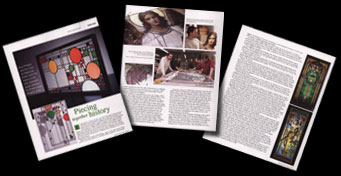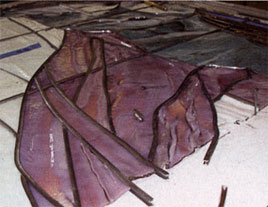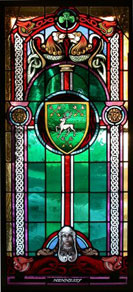|
|
In The News
From M Magazine
Piecing Together History
 Paul Phelps and his crew at Oakbrook Esser hold the honor of being the only licensed glass artisans for Frank Lloyd Wright’s work.
Paul Phelps and his crew at Oakbrook Esser hold the honor of being the only licensed glass artisans for Frank Lloyd Wright’s work.
| By Judy Steininger |
February 2007 |
|
|
Immersed in 4 inches of water, the 9-foot tall angel is lying in pieces. Her thick, brown, feathered wings, her cream-colored gown, the pastel flowers that have encircled her for decades, are being gently pried apart in a large trough by an artisan at the Oakbrook Esser Studios in Oconomowoc. However, soon she’ll be reassembled in all her radiant glory, just like the day in 1892 when she came out of the Tiffany Studio in New York. She won’t fly, but the 13-foot diameter rose window she centers will be trucked back to Oshkosh and re-installed at the Trinity Episcopal Church.
Welcome to the world of Paul Phelps, owner of the glass studio. While scarcely a ho-hum experience, restoring Tiffany windows is what Phelps and his artisans do every day. Little Oconomowoc is a shipping address from all over the world whenever a cathedral, chapel, castle or Hollywood mansion needs a stained glass window restored, replicated or designed.
|
 |
A closeup of a stained glass window during restoration. |
|
|
|
The rainbow is composed of the colors red, orange, yellow, green, blue, indigo and violet, but when Oakbrook Esser orders glass from its major supplier, Lamberts in Germany, it can choose from a palette of 5,000 colors. Walking into the gallery at the front of the studio is an opportunity to lose oneself in a garden of visual delights, time-travel to places where stained glass windows were used to teach, mourn a little that mass production controls our current environment, and peek into the future.
|
|
 |
|
|
|
Otto holds the head of an angel that is part of an 1892 Tiffany window (left)which Oakbrook Esser Studios is restoring for an Oshkosh Church.
|
|
|
A high compliment to Phelps and the studio is that for the past 24 years they have had the honor of being the only one licensed by the Frank Lloyd Wright Foundation (located at Taliesin West in Scottsdale, Ariz.) to restore and replicate the master architect’s windows. “The idea started with Wright’s widow, Olgivanna, who wanted to help fund Wright’s legacy and share with the masses his windows, table settings, clothing, furniture and fabrics, however, all of it must be done to the very strict approval of the foundation.” Phelps says.
|
|
 |
“Originally, during the 1980s, four companies were selected: Tiffany’s did the sterling silver; Schumacher, also in New York, did the fabrics, rugs and wallpaper; Cassina of Italy did the furniture; and Oakbrook Esser was chosen to do the glass. It was such a thrill for me to make numerous trips to New York, sit in the boardroom at Tiffany’s and work with companies like this. I loved opening up copies of ‘Architectural Digest’ to see the foundation’s ads, which read: ‘Italy, New York, Oconomowoc!’ Out of the original four, Oakbrook Esser and Schumacher are the only two surviving and we must be re-licensed every three years. We are just renewed for the eighth time. In our world we’re the best. It doesn’t matter where we’re located – we can do the work. We’re contributing to the legacy of one of the greatest architects of all time.”
|
Phelps has visited nearly all Wrights buildings in the United States and worked on many. Three structures illustrate the range of the studio’s involvement. The Darwin Martin House in Buffalo, N.Y. had “extensive glass work. Because it sat empty for a number of years, the city bought it and began restoration. Many of the windows were gone or beyond repair so we’re making 30 new windows for them. This is probably one of the biggest restorations we’ll ever do. Fortunately, as the foundation’s licensee, we have complete access to Wright’s drawings and design.”
In Chicago, where Wright began his career, Phelps has done restoration on what is know as the Bradley House. “Some people overlook this one because it is an early Wright commission for a private owner. It has 168 windows, and I find it interesting because he was developing his signature style of light. Looking at it and other structures you can see his art glass changed over time.”
A very different experience for Phelps is the Midway Garden windows project, also in Chicago. “The beer garden was, I guess they say, ‘razed’, destroyed in my way of thinking. But we have the drawings so we can reproduce them and we’ve even made windows that were never actually executed.”
|
|
|
|
 |
Phelps also adds class to the architecture of celebrities including Donald Trump at the Crown Plaza Hotel, comedian Richard Lewis, philanthropist Lucy Rockefeller and the late singer-songwriter-humanitarian Harry Chapin. “I’ve done Hollywood types but I respect the privacy of my clients.
”Phelps is a first generation American; his parents and sister were born in England. He grew up in the Oconomowoc area and like many in his field, including his own artisans, learned and educated himself by doing. “I love, support and collect art. I need art, can’t live without it. It’s the most stimulating thing around. I love buildings and the creativity of architecture. A home for me should be something that nurtures and is intimate. When it’s done effectively, as you walk in, there is this unexplained feeling that everything is perfect. History and preservation are a big part of who I am. Glass appeals to me because of its history, storytelling and spiritual base.”
Partly by design and partly because it can’t be improved on, Phelps says “not much has changed in the techniques of stained glass; I choose not to change. We have electricity now, but we’re preserving not just the window, but also the craft itself. We seek out the methods of the past and make sure we adhere to them. If we don’t pass these along, we lose them with the last person who knows how.”
|
|
An important bridge to the past currently working in the studio is Johann Minten. As picturesque in his own way as the splendid pieces he restores. Minten is 79 years old; he’s been working with stained glass since he was 14. Raising his head wreathed in long white hair, the gentle man says in this thick German accent that he is “from Kevelaer, Germany, a pilgrimage place.” Phelps relies on Minten’s experiences in Kevelaer’s Hein Derix Glass Studio.
The gallery located on the first floor of the studio contains several significant pieces from the Mayer of Munich Studio founded in 1847. The oldest piece Phelps owns is from the 14th century. Miscellaneous glass pieces which had been stored in the basement of Marble House (a Rockefeller home in Newport, R.I.) were put up for auction. Serendipitously, Phelps bought the lot and discovered later the treasure he had purchased. He kept the small 14th century piece and donated the rest back to Marble House. Although Phelps “loves” old glass, he keeps his eyes open for contemporary pieces like those of Vermont artist Janet McKenzie, whose interpretations of themes like the Nativity stand in beautiful contrast to the old European styles. Phelps’ own work can be seen in the curved glass piece titled “Monarchs” which captures the butterflies’ ethereal quality.
|
|
|
Walking into the studio is like walking into a glass library. Shelves of glass sorted by color and texture run floor to ceiling and back to front. The area is also as quiet as a library. Huge worktables allow space for sketches and tracings of pieces to be restored or designed. Phelps travels the world to meet with people who want his designs for a specific space. He soaks up the ambience of the setting, measures, confers with the clients, and then returns to his studio for the collaborative effort that will bring forth a glowing work of art that can last for centuries.
Surprisingly, every one of the men in the studio has all 10-hand digits even though they work every day with glass and sharp tools. Artisans Peter Grosser, Man Muller, Randy Brendemuehl, Mike Vannucci, Otto Ohlsson and Peter Krauski have learned their unique craft mostly as apprentices. They are long-term employees of Oakbrook Esser.
On the third floor, they work with the glass that comes from the “basic elements of quartz sand, limestone, potash” and the intense heat which melds them together. Phelps explains minerals mixed in with those basics are what give the glass the color. “For example, cobalt makes blue, copper makes green and we even use gold and silver. The realistic renderings of the faces, hands and folds in a robe seen in a church window are painted on the glass before it is fired. If a piece is done properly, it will never fade.”
|
|
Good art never does, at least metaphorically speaking. There must be a place in heaven where flat land and linear plowed fields are intersected by meandering rivers and where celestial light produces golden and earth tone colors. Surely, Frank Lloyd Wright is there watching serenely as the people at Oakbrook Esser take fastidious care of his legacy and share with the world his and their art.
| Right: Otto Ohlsson (clockwise from left), Mike Vannucci, Paul Phelps, Peter Krauski, and Peter Grosser work on a restoration project together. |
|
|
|
|